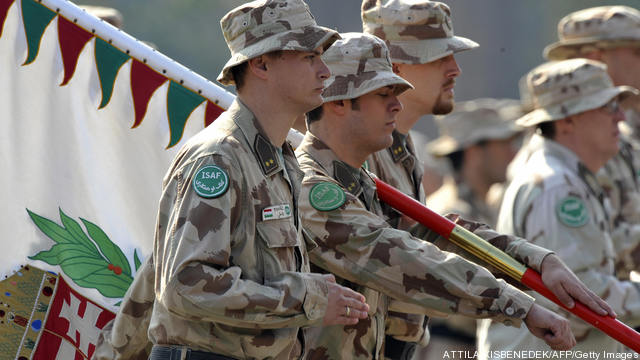Hungary Is Hungry for Hueys; Defense Minister Hopes For ‘A Donation’ EXCLUSIVE
Posted on

UPDATED: Friday Sept. 14, 6:52 p.m..
WASHINGTON: Hungary’s defense minister, Csaba Hende, went to see Defense Secretary Leon Panetta at the Pentagon today and won praise for his tiny Central European nation’s contributions in Afghanistan and elsewhere in the world. A spokesman, though, said Hende didn’t raise another issue he discussed in an exclusive interview with Breaking Defense. Former Warsaw Pact member Hungary, a NATO member since 1999, needs to replace some old Russian-made helicopters, and the Marine Corps has 24 “excess defense article” UH-1N Hueys that Hende thinks would do nicely.
“This would be a donation,” Hende said in the interview, speaking through an interpreter in an interview conducted Thursday before he went to Joint Base Andrews outside Washington to look over Marine and Air Force configurations of the Hueys and take a ride in one.
U.S. and Hungarian officials have been negotiating the possible aircraft donation for some time, but no final decision is expected before Nov. 6.
“The U.S. intends to support the capability development of the Hungarian defense forces (in any event),” Hende noted. “This would also be a sign of appreciation for the enormous efforts that Hungary has been doing in the theaters of Afghanistan, the Balkans and a number of other theaters around the world.”
Hende suggested Hungary deserves such consideration because it’s been swimming against the Atlantic alliance tide in two ways. “Everyone is pulling out from Afghanistan, we are putting in,” he said. “Everyone is decreasing their defense spending, and we just decided to increase ours.”
(Hende was speaking rhetorically. There have been exceptions, such as Poland, which is increasing its defense spending for 2013 by 6.74 percent, according to its Ministry of Defense website.)
Hungary’s numbers are a lot smaller, but so is Hungary, whose population is just under 10 million and whose military numbers only 25,000. The Hungarian Defense Force currently has 452 troops in Afghanistan but will increase that to an even 500 as of Oct. 1, when the Hungarians are to take over security at Kabul International Airport for six months.
The Hungarian defense budget is only about $1.1 billion — less than the Pentagon spends on goods and services each day, and less than the 2 percent of Gross Domestic Product (GDP) expected of former Communist nations that joined NATO in the late 1990s. Prime Minister Viktor Orban’s conservative government, though, decided in February to hold defense spending at its current 240 billion Hungarian Forints a year through 2016 and then increase it every year from then until 2022 by 0.1 percent of GDP.
Small as Hungary’s contingent in Afghanistan is, its members stay busy. They have been helping train Afghan troops, running a Provincial Reconstruction Team in Baghlan Province, training Afghan air crews to fly Russian-made Mi-17 and Mi-25 helicopters, plus providing an explosive ordinance disposal unit and a Special Operations Task Group. In all, Hende said, seven Hungarian troops have died in Afghanistan, six counted as KIA.
Pápa Air Base in western Hungary, meanwhile, serves as home base for a 12-nation Strategic Air Capability Program, run by the U.S. Air Force since 2009, which operates three Boeing C-17 Globemasters on missions ranging from hauling cargo to Afghanistan to taking humanitarian aid to Haiti. NATO bought two of the C-17s and the United States donated one, Boeing spokesman Damien Mills said. The United States, nine other NATO nations and Partners for Peace members Finland and Sweden each underwrite, on a proportional basis, the expense of flying the planes 1,000 hours a year, he added.
Besides meeting with Panetta on Friday, Hende was to travel over the weekend to Tampa to visit Central and Special Operations commands. “We’ve been receiving major assistance and support from the United States in increasing and further developing the Hungarian special operations forces capability,” the defense minister said.
Hungary keeps about 1,000 of its 25,000 troops deployed abroad, Hende noted, with the second largest contingent assigned to NATO peacekeeping missions in Bosnia-Herzegovina and Kosovo. Hungary also recently extended through 2026 a lease on 14 JAS-39 Gripen multirole fighter jets that was to expire in 2016, in part to take a turn flying Baltic air patrols with other NATO nations. NATO agreed to provide the patrols when Estonia, Latvia and Lithuania joined the alliance in 2004 over Russia’s objections.
The mission will be good training for Hungarian pilots because the Russians “just keep testing the capabilities and the patience of the NATO air forces deployed there each and every day,” Hende said. The Russians often launch bombers “directly towards Riga” and have them turn away just before the border, he said. “Soldiers are like big children, so they like to play around.”
Subscribe to our newsletter
Promotions, new products and sales. Directly to your inbox.
